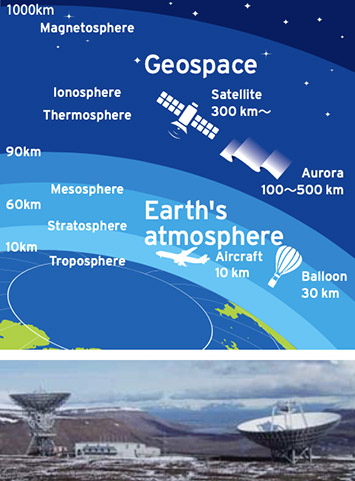National Institute of Polar Research
Study on coupling processes in the solar-terrestrial system based on synthetic space and upper/middle atmospheric observations in both polar regions

Understanding the linkage among the Sun, geospace and Earth’s atmosphere
Principal Investigator Masaki TSUTSUMI

Earth's atmosphere and geospace studied in this project, with a picture of the EISCAT Svalbard Radar
Clarifying the mechanism of the solar-terrestrial system variation from both polar regions.
This project aims to clarify the coupling processes among the Sun, geospace and Earth's atmosphere in polar regions. To achieve this objectives, we are strengthening national and international collaborative studies with facilities in both polar regions; Antarctic atmospheric radar (PANSY) at Syowa Station; European Incoherent Scatter (EISCAT) radars in northern Scandinavia and Svalbard; SuperDARN HF radar network, and ; Ground-based networks of optical imagers and magnetometers. We are also developing new observation systems such as optical imagers, lidars, and the next-generation geospace/atmospheric radar called ‘EISCAT_3D’. Based on these ground-based remote-sensing together with satellite observations and theoretical/ simulation studies, we will pursue quantitative understanding and future prediction of the coupling processes among the Sun, geospace and Earth's atmosphere.









